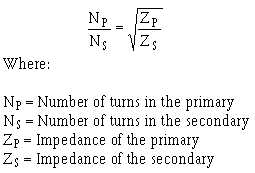1-17
The common-emitter configuration provides a medium input impedance and a medium output
impedance. The common-base configuration provides a low input impedance and a high output
impedance. The common-collector configuration provides a high input impedance and a low output
impedance. The common-collector configuration is often used to provide impedance matching between a
high output impedance and a low input impedance.
If the amplifier stage is transformer coupled, the turns ratio of the transformer can be selected to
provide impedance matching. In NEETS Module 2, Introduction to Alternating Current and
Transformers, you were shown the relationship between the turns ratio and the impedance ratio in a
transformer. The relationship is expressed in the following formula:
As you can see, impedance matching between stages can be accomplished by a combination of the
amplifier configuration and the components used in the amplifier circuit.
Q-18. What impedance relationship between the output of one circuit and the input of another circuit
will provide the maximum power transfer?
Q-19. If maximum current is desired at the input to a circuit, should the input impedance of that circuit
be lower than, equal to, or higher than the output impedance of the previous stage?
Q-20. What are the input- and output-impedance characteristics of the three transistor configurations?
Q-21. What transistor circuit configuration should be used to match a high output impedance to a low
input impedance?
Q-22. What type of coupling is most useful for impedance matching?



